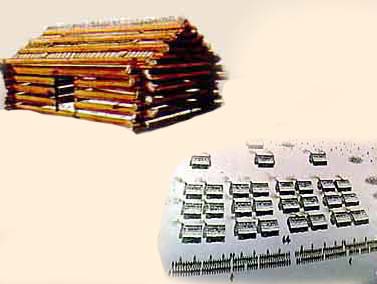 |
|
|
|
 he Continental Army of over 10,000 soldiers reached Jockey Hollow, their "wintering ground" in the bitter weather of December 1779. The area was a windswept forest in the hills a few miles southwest of Morristown, NJ. he Continental Army of over 10,000 soldiers reached Jockey Hollow, their "wintering ground" in the bitter weather of December 1779. The area was a windswept forest in the hills a few miles southwest of Morristown, NJ.
|
|
|
|
Click image to enlarge |
|
|
 |
 |
 |
|
|
|
 nticipating a long encampment at this advantageous position, Washington decreed that his army was to build a "Log-house city" here. Eight infantry brigades occupied the site for seven months. More than 600 acres of oak, walnut and chestnut were converted into lines of soldier huts that rose on the hillsides. Impeded by the weather, the work of felling the great forest and erecting hundreds of cabins went slowly. Almost all of December, the men slept under tents or with no covering at all. A number were not under roofs until February the following year. There were about 1,000 to 1,200 log structures in Jockey Hollow. nticipating a long encampment at this advantageous position, Washington decreed that his army was to build a "Log-house city" here. Eight infantry brigades occupied the site for seven months. More than 600 acres of oak, walnut and chestnut were converted into lines of soldier huts that rose on the hillsides. Impeded by the weather, the work of felling the great forest and erecting hundreds of cabins went slowly. Almost all of December, the men slept under tents or with no covering at all. A number were not under roofs until February the following year. There were about 1,000 to 1,200 log structures in Jockey Hollow.
|
|
|
 |
 |
 |
|
 |
 |
 |
|
 |
|
|
|
 ockey Hollow, where the log city stood, through most of its history was farmland. Mary Cooper Wick and her daughter Temperance were the only family members living on the 1,400-acre farm during the winter of 1779-1780. Henry Wick served as a volunteer with the Morris County cavalry. Mr. Wick had officers staying in his house that winter. Major General Arthur St. Clair, along with two aides, rented two rooms in the house for their office, dining room and bedrooms. General St. Clair was in charge of over two thousand Pennsylvania soldiers. ockey Hollow, where the log city stood, through most of its history was farmland. Mary Cooper Wick and her daughter Temperance were the only family members living on the 1,400-acre farm during the winter of 1779-1780. Henry Wick served as a volunteer with the Morris County cavalry. Mr. Wick had officers staying in his house that winter. Major General Arthur St. Clair, along with two aides, rented two rooms in the house for their office, dining room and bedrooms. General St. Clair was in charge of over two thousand Pennsylvania soldiers.
|
|
|
|
|
|
|
|
|
|
|
|
|
|

